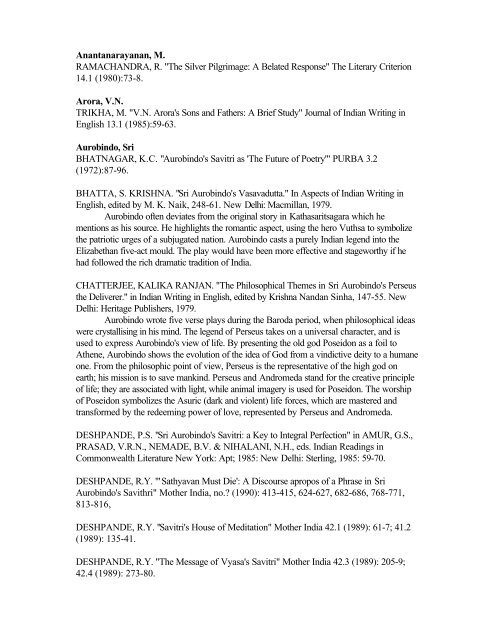india author m 1- a-nan - University of Wollongong
india author m 1- a-nan - University of Wollongong
india author m 1- a-nan - University of Wollongong
Create successful ePaper yourself
Turn your PDF publications into a flip-book with our unique Google optimized e-Paper software.
A<strong>nan</strong>tanaraya<strong>nan</strong>, M.<br />
RAMACHANDRA, R. "The Silver Pilgrimage: A Belated Response" The Literary Criterion<br />
14.1 (1980):73-8.<br />
Arora, V.N.<br />
TRIKHA, M. "V.N. Arora's Sons and Fathers: A Brief Study" Journal <strong>of</strong> Indian Writing in<br />
English 13.1 (1985):59-63.<br />
Aurobindo, Sri<br />
BHATNAGAR, K.C. "Aurobindo's Savitri as 'The Future <strong>of</strong> Poetry'" PURBA 3.2<br />
(1972):87-96.<br />
BHATTA, S. KRISHNA. "Sri Aurobindo's Vasavadutta." In Aspects <strong>of</strong> Indian Writing in<br />
English, edited by M. K. Naik, 248-61. New Delhi: Macmillan, 1979.<br />
Aurobindo <strong>of</strong>ten deviates from the original story in Kathasaritsagara which he<br />
mentions as his source. He highlights the romantic aspect, using the hero Vuthsa to symbolize<br />
the patriotic urges <strong>of</strong> a subjugated nation. Aurobindo casts a purely Indian legend into the<br />
Elizabethan five-act mould. The play would have been more effective and stageworthy if he<br />
had followed the rich dramatic tradition <strong>of</strong> India.<br />
CHATTERJEE, KALIKA RANJAN. "The Philosophical Themes in Sri Aurobindo's Perseus<br />
the Deliverer." in Indian Writing in English, edited by Krishna Nandan Sinha, 147-55. New<br />
Delhi: Heritage Publishers, 1979.<br />
Aurobindo wrote five verse plays during the Baroda period, when philosophical ideas<br />
were crystallising in his mind. The legend <strong>of</strong> Perseus takes on a universal character, and is<br />
used to express Aurobindo's view <strong>of</strong> life. By presenting the old god Poseidon as a foil to<br />
Athene, Aurobindo shows the evolution <strong>of</strong> the idea <strong>of</strong> God from a vindictive deity to a humane<br />
one. From the philosophic point <strong>of</strong> view, Perseus is the representative <strong>of</strong> the high god on<br />
earth; his mission is to save mankind. Perseus and Andromeda stand for the creative principle<br />
<strong>of</strong> life; they are associated with light, while animal imagery is used for Poseidon. The worship<br />
<strong>of</strong> Poseidon symbolizes the Asuric (dark and violent) life forces, which are mastered and<br />
transformed by the redeeming power <strong>of</strong> love, represented by Perseus and Andromeda.<br />
DESHPANDE, P.S. "Sri Aurobindo's Savitri: a Key to Integral Perfection" in AMUR, G.S.,<br />
PRASAD, V.R.N., NEMADE, B.V. & NIHALANI, N.H., eds. Indian Readings in<br />
Commonwealth Literature New York: Apt; 1985: New Delhi: Sterling, 1985: 59-70.<br />
DESHPANDE, R.Y. "'Sathyavan Must Die': A Discourse apropos <strong>of</strong> a Phrase in Sri<br />
Aurobindo's Savithri" Mother India, no.? (1990): 413-415, 624-627, 682-686, 768-771,<br />
813-816,<br />
DESHPANDE, R.Y. "Savitri's House <strong>of</strong> Meditation" Mother India 42.1 (1989): 61-7; 41.2<br />
(1989): 135-41.<br />
DESHPANDE, R.Y. "The Message <strong>of</strong> Vyasa's Savitri" Mother India 42.3 (1989): 205-9;<br />
42.4 (1989): 273-80.

















